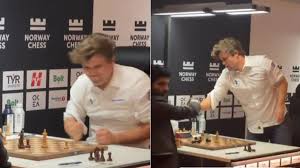Can Norway Chess’ unique time-control tweaks spice up classical chess endgames?

For decades, classical chess has maintained a reputation for deep strategy, subtle maneuvering, and often, drawn-out endgames that test the patience of players and spectators alike. While purists celebrate the depth and beauty of these long encounters, the modern audience—spoiled by fast-paced formats like blitz and rapid—sometimes finds classical endgames tedious. That’s where Norway Chess is flipping the board.
By introducing a bold and unconventional twist to time controls, Norway Chess is attempting something revolutionary: making classical endgames exciting again.
The Traditional Time Trap
To understand why Norway Chess’s changes matter, it helps to understand the status quo.
In most elite classical events, players are given a generous amount of time—often 90 minutes for the first 40 moves, followed by additional time with a 30-second increment per move. This allows grandmasters to calculate deeply and maintain control, especially in endgames. But it also means that many endgames settle into a rhythm of caution and repetition, often leading to uneventful draws.
Fans and organizers have long struggled with this. While classical chess showcases the highest level of strategic depth, its slow tempo sometimes alienates casual viewers. The last few years have seen a push for faster formats—but Norway Chess has gone in a different direction: not by speeding everything up, but by cleverly altering the clock itself.
Norway Chess: Time Control With a Twist
The Norway Chess tournament has implemented a hybrid time format that blends traditional classical play with modern drama:
- Each player gets 120 minutes for the entire game.
- No increment is given until move 40.
- After move 40, a 10-second increment is added per move.
- If the game ends in a draw, the players head straight into an Armageddon tiebreak—a faster game where Black gets draw odds, forcing White to play for a win.
This structure accomplishes something that few other tournaments do: it injects time pressure at precisely the moments that classical games often lose their intensity—the endgame.
How It Revives the Endgame
The most striking impact of this time tweak is in how it transforms endgame dynamics.
1. Fighting Against the Clock
Without increment for the first 40 moves, players frequently reach endgames with mere minutes—or even seconds—left on the clock. This forces quicker, riskier decisions in positions that normally require deep, slow calculation.
Suddenly, a quiet endgame becomes a minefield. One slip, and the opponent capitalizes. The tension is palpable. Fans watch as top-level grandmasters navigate complex technical positions while staring down the clock—turning what might have been a dry conclusion into a high-stakes thriller.
2. Reduced Draw Death
Knowing that a draw leads to an Armageddon playoff, players—especially with White—are more willing to push in endgames. They seek imbalance, provoke weaknesses, and play for complications. The result? Fewer sterile draws and more decisive outcomes, even in positions where traditional events would see peace signed.
3. Greater Entertainment for Spectators
With tight clocks, blunders and brilliancies emerge in equal measure. Fans love drama, and Norway Chess delivers it. When a player blunders an easy draw into a loss because of time trouble—or saves a lost position with seconds left—those are the moments that go viral.
The time format brings the raw intensity of blitz into the solemn world of classical chess, without compromising the depth of play in the earlier phases.
Case Studies From the Board
The 2023 and 2024 editions of Norway Chess showcased how effective this format can be.
- In several matches, players entered endgames with fewer than 3 minutes on the clock, navigating rook and pawn battles under intense time pressure.
- Magnus Carlsen, a long-time advocate of quicker and more engaging chess formats, thrived under these conditions. His games often transitioned from balanced middlegames into sharp, resourceful endgames—where clock management became as critical as calculation.
- Hikaru Nakamura, known for his speed, gained advantages over slower, more methodical opponents in the late game, proving that quick thinking in time-trouble endgames can yield real dividends.
These moments weren’t just exciting—they were decisive. Points were won and lost in what would usually be uneventful endgames.
Purists vs Innovators
Of course, not everyone is thrilled.
Traditionalists argue that classical chess is about precision, not pressure. They worry that these tweaks dilute the purity of endgame play and encourage chaos over clarity. They also point out that some of the best endgame studies in chess history were born out of long, careful maneuvering—not frantic time scrambles.
But Norway Chess isn’t trying to replace classical chess—it’s trying to evolve it. In an age where attention spans are shorter and streaming culture thrives on excitement, these innovations ensure classical chess remains relevant and engaging.
A Model for the Future?
Norway Chess has found a sweet spot: keeping classical games long enough to allow for deep play, but short enough to invite drama. The Armageddon tiebreak ensures that each game delivers a result, and the time pressure reshapes the way players approach the final phase of the game.
Other tournaments are starting to take notice. While it may not replace traditional formats like the Candidates Tournament or the World Championship cycle, the Norway Chess model offers a compelling alternative for future events looking to balance integrity with entertainment.
Final Thoughts
In a game as ancient as chess, change comes slowly. But Norway Chess proves that even small innovations—like a tweak in time control—can breathe new life into the classical format. By making endgames unpredictable, emotionally charged, and visually gripping, the tournament is doing more than entertaining fans; it’s redefining what classical chess can look like in the 21st century.
Yes, the tweaks are unconventional. But sometimes, the best moves in chess are the ones no one sees coming.






